Jenway 7305 User Manual
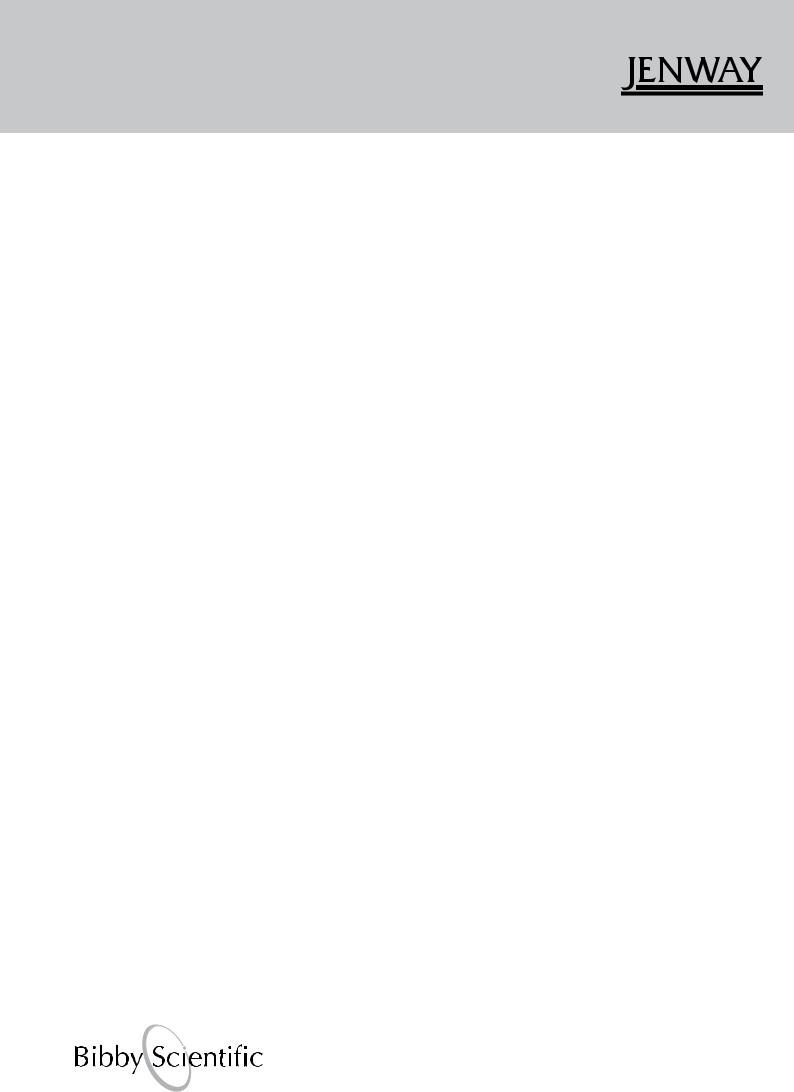
Spectrophotometers
Models 7300 & 7305
Operating Manual
730 005 REV E /12-10

2
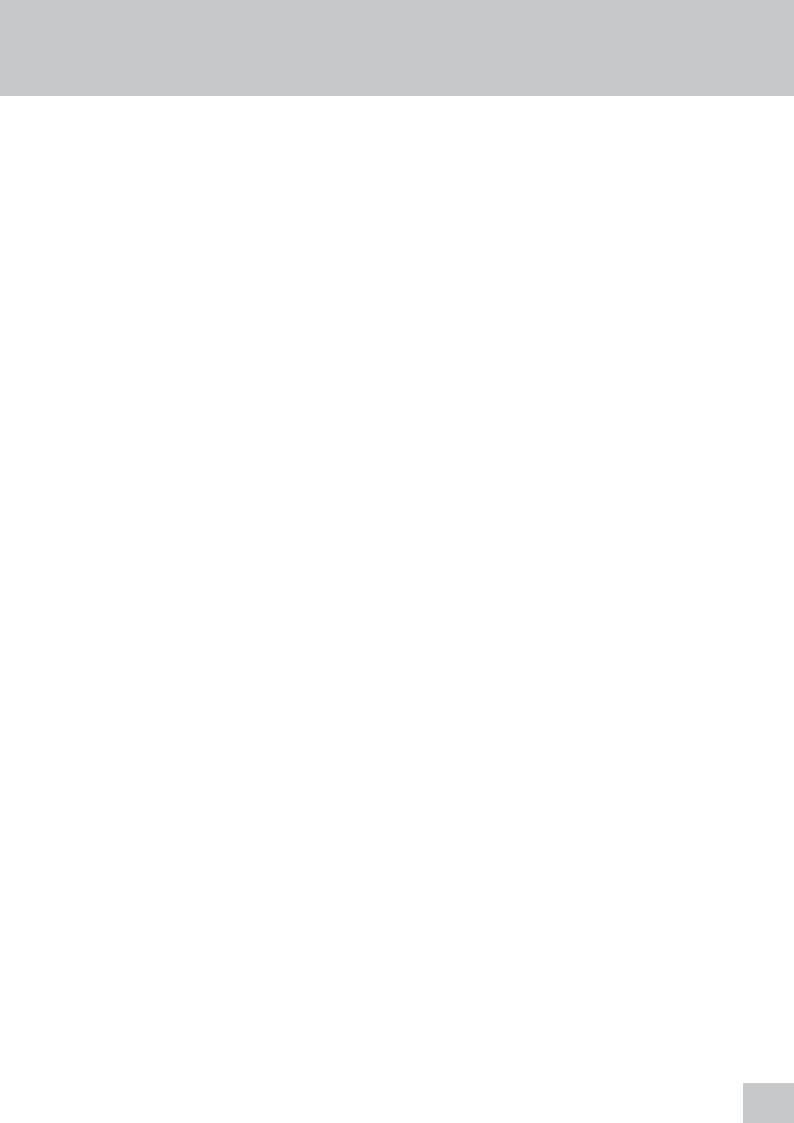
Safety
Please read this information carefully prior to installing or using this equipment.
1.The unit described in this manual is designed be operated only by trained personnel. Any adjustments, maintenance and repair must be carried out as defined in this manual, by a person qualified to be aware of the hazards involved.
2.It is essential that both operating and service personnel employ a safe system of work, in addition to the detailed instructions specified in this manual.
3.Other than for those items defined in the maintenance procedures herein there are no user serviceable items in this instrument. Removal of covers and attempted adjustment or service by unqualified personnel will invalidate the warranty and may incur additional charges for repair.
4.References should always be made to the Health and Safety data supplied with any chemicals used. Generally accepted laboratory procedures for safe handling of chemicals should be employed.
5.If it is suspected that safety protection has been impaired in any way, the unit must be made inoperative and secured against any intended operation. The fault condition should immediately be reported to the appropriate servicing authority.
3

4

Contents
|
|
Page |
Safety |
|
3 |
Section 1 - Introduction |
8 |
|
1.1 |
Instrument description |
8 |
1.2 |
Instrument specification |
8 |
Section 2 - Installation |
9 |
|
2.1 |
Unpacking |
9 |
2.2 |
Installation |
9 |
2.3 |
Display |
10 |
2.4 |
Controls |
11 |
2.5 |
Rear panel |
12 |
2.6 |
Front panel |
12 |
Section 3 - Theory and practice of spectroscopy measurements |
13 |
|
3.1 |
Theory of spectroscopy measurement |
13 |
3.2 |
Spectroscopy measurement |
13 |
3.3 |
Good practice guidelines |
14 |
Section 4 - Instrument setup |
16 |
|
4.1 |
Navigating and screen setup |
16 |
4.2 |
Time and date |
17 |
4.3 |
Instrument settings menu |
17 |
4.4 |
Diagnostics |
18 |
4.5 |
Screen contrast |
18 |
4.6 |
Lamp save |
18 |
Section 5 - Photometrics |
20 |
|
5.1 |
Mode specific parameters |
20 |
5.2 |
Method set up |
20 |
5.2.1 |
Selecting a wavelength |
21 |
5.3 |
Calibration |
21 |
5.4 |
Sample measurment |
21 |
Section 6 - Concentration |
22 |
|
6.1 |
Mode specific parameters |
22 |
6.2 |
Method setup |
22 |
6.2.1 |
Selecting a wavelength |
22 |
6.2.2 |
Settings |
23 |
6.2.2.1 |
Selecting concentration units |
23 |
6.2.2.2 |
Changing the resolution |
24 |
6.2.2.3 |
Using a standard |
24 |
6.2.2.4 |
Using a factor |
24 |
6.3 |
Calibration |
24 |
6.3.1 |
Calibrating to a standard |
24 |
51

6.3.2 |
Calibrating to a factor |
25 |
6.4 |
Sample measurement |
25 |
6.4.1 |
Measuring a sample after calibrating to a standard |
25 |
6.4.2 |
Measuring a sample after calibrating to a factor |
25 |
SECTION 7 – PRINTING AND AUTOLOGGING |
26 |
|
7.1 |
Printing |
26 |
7.1.1 |
Print Setup |
26 |
7.1.2 |
Printing Results |
27 |
7.2 |
Autologging |
27 |
7.2.1 |
Setting the Number of Sample Repetitions |
27 |
7.2.2 |
Selecting Result’s Destination |
28 |
7.3 |
Connecting to a PC |
28 |
Section 8 - Accessories and spare parts |
29 |
|
8.1 |
Optional accessories |
29 |
8.2 |
Connecting the accessories |
29 |
8.2.1 |
Internal printer |
29 |
8.2.2 |
Passive accessories |
30 |
8.2.3 |
Active accessories |
30 |
8.2.3.1 |
Automatic 8 cell turret |
31 |
8.2.3.2 |
Peltier |
31 |
8.2.3.3 |
Sipper pump |
32 |
8.2.3.4 |
Combined sipper peltier pump |
33 |
8.3 |
Using the accessories |
34 |
8.3.1 |
Automatic 8 cell turret |
34 |
8.3.2 |
Peltier |
34 |
8.3.3 |
Sipper pump |
35 |
8.3.3.1 |
Manual sipper pump settings |
35 |
8.3.3.2 |
Timed sipper pump settings |
36 |
8.3.4 |
Combined sipper peltier pump |
38 |
8.4 |
Spares |
39 |
Section 9 - Maintenance and service |
40 |
|
9.1 |
Routine maintenance |
40 |
9.2 |
Lamp replacement |
40 |
9.2.1 |
Tungsten halogen lamp replacement |
40 |
9.2.2 |
Xenon lamp module replacement |
40 |
9.3 |
Service |
41 |
Section 10 - Troubleshooting |
42 |
|
10.1 |
Error codes |
42 |
10.2 |
Troubleshooting guide |
44 |
10.3 |
Technical support |
44 |
Section 11 - Declaration of conformity |
45 |
|
Section 12 - Glossary of icons |
47 |
|
Index |
|
54 |
6

7

Section 1 - Introduction
1.1INSTRUMENT DESCRIPTION
The 7300 and 7305 spectrophotometers are suited to a wide range of applications in education, quality control, environmental and clinical analysis. The 7300 is a visible spectrophotometer covering a wavelength range from 320nm to 1000nm. The 7305 is a UV/Visible spectrophotometer with a wavelength range from 198nm to 1000nm. Both models feature measurement modes for absorbance, % transmittance and concentration. These instruments use icon driven software and have an improved navigation system for easy and intuitive usability.
1.2inSTRUMENT SPECIFICATION
|
7300 |
7305 |
Wavelength |
|
|
Range |
320 to 1000nm |
198 to 1000nm |
Resolution |
|
1nm |
Accuracy |
|
± 2nm |
Repeatability |
|
± 0.5nm |
Spectral bandwidth |
|
5nm |
Photometrics |
|
|
Transmittance Absorbance Accuracy Resolution Stray light
Concentration
Range
Resolution
Calibration
Units
Factor
Standard
Other
Beam height Light source Lamp save GLP Outputs Power
Size (w x d x h) Weight
0 to 199.9% -0.300 to 2.500A
±1%T, ±0.01Abs at 1.000 Absorbance
|
0.1%T, 0.001A |
<0.5% at 340nm |
<0.5% at 340nm and 220nm |
-300 to 9999 Selectable 1/0.1/0.01/0.001
Blank with a single standard or factor
no units, %, ppm, EBC, SRM, mEq/l, mEq, M, mM, µM, nM, U, U/l, U/ml, g/l, mg/l, µg/l, ng/l, g/dl, mg/dl, µg/dl, mg/ml, µg/ml, ng/ml, µg/µl, ng/µl, mol/l, mmol/l
0.001 to 10000
0.001 to 1000
|
15mm |
Tungsten halogen lamp |
Xenon lamp |
Yes |
Not applicable |
Current time and date
USB, Analogue, RS232, Internal printer 24V
275 x 400 x 220mm 6kg
8
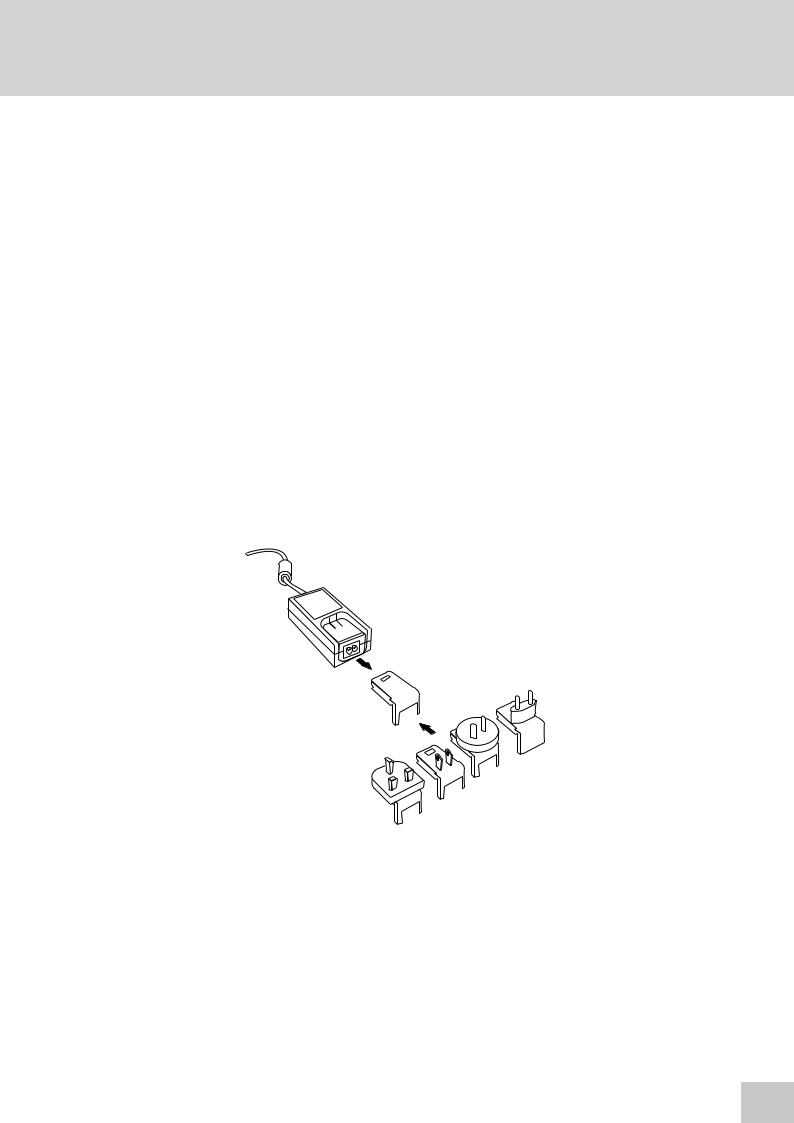
Section 2 - Installation
2.1UNpACking
Remove the 7300 or 7305 from the packaging and ensure the following items are included:
1.Model 7300 spectrophotometer (730 001), or Model 7305 spectrophotometer (730 501)
2.24V 65W power supply unit (021 060)
3.Pack of 100 disposable plastic visible wavelength cuvettes (060 084), or pack of 100 disposable UV plastic cuvettes (060 230)
4.Jenway 73 series PC software (735 100) and interface cable (013 203)
5.Instruction manual (730 005)
6.Jenway Foreign Manual CD (JENMANCD)
7.Optional accessories (as ordered)
2.2inSTALLATION
Models 7300 and 7305 are supplied ready to use.
The unit should be placed on a clean flat surface which is free from drafts and vibrations. The units are designed for operation on 90V to 264V AC input at 47 to 63Hz. Select the correct plug attachment and attach to the power supply unit as shown below:
Fig 2.2.1 – Power supply unit with various plugs
Connect the power supply unit to the power inlet socket on the rear panel of the instrument and connect to the mains socket. Turn the power on at the mains and switch the instrument on using the power switch on the rear of the instrument.
The instrument will perform several power on tests before displaying the main menu:
9

1
2
7300 |
3
4
09:02
Fig 2.2.2 – All Power On Tests Complete
1.Instrument check – ensures the validity of the saved parameters
2.Dark test
3.Checks for the accessory fitted. If an active accessory is found the instrument verifies communication and response
4.Self calibration of wavelengths
2.3DISPLAY
These spectrophotometers have a dot matrix display which enables icons and graphs to be displayed clearly. Following successful completion of the power on tests the main menu screen will be displayed:
7300
1 |
5 |
|
09:02
2
3 |
4 |
Fig. 2.3.1 – Display
1.Photometrics measurement mode
2.Back key
3.Time and date menu
4.Instrument settings menu
5.Concentration measurement mode
10
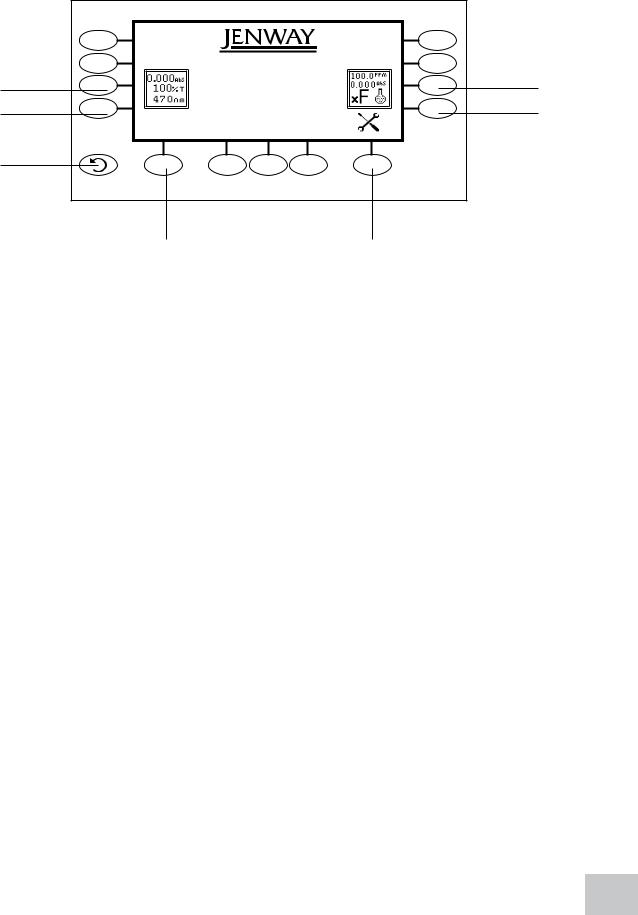
2.4CONTROLS
The keypad used for these models enables an easy and effective way of navigating the different measurement modes, entering numbers, saving and analysing results. The soft keys are active when an icon is displayed above or adjacent to the key. The only exception to this is the back key which is always active.
The main menu screen and surrounding keypad is displayed below.
|
7300 |
1 |
5 |
1 |
5 |
|
09:02 |
2 |
|
3 |
4 |
Fig. 2.4.1 – Display
1.Photometrics measurement mode
2.Back key
3.Time and date menu
4.Instrument settings menu
5.Concentration measurement mode
11

2.5REAR PANEL
The image below shows the rear panel on the instrument:
2
3
4
5 |
1 |
|
|
Fig. 2.5.1 – Rear Panel |
1. |
Lamp access panel |
Allows access to lamp when replacement is necessary |
2. |
Power switch |
On/off switch for the unit |
3. |
Power in socket |
Connection socket for power supply unit |
4. |
RS232 serial port |
Connection to a PC or external serial printer |
5. |
Output sockets |
Analogue output |
2.6FRONT PANEL
The image below shows the front panel of the instrument:
1
2 

 4
4
3
Fig. 2.6.1 – Front Panel
1.Integral printer (optional accessory)
2.Keypad
3.Instrument lid
4.Display
12

SECTION 3 – Theory and Practice of Spectroscopy Measurements
3.1THEORY OF SPECTROSCOPY MEASUREMENT
UV-visible spectroscopy is the measurement of the absorbance of light at a specific wavelength in a sample. This is used to identify the presence and concentration of molecular entities within the sample. The Beer-Lambert law is used to relate the absorption of light to the properties of the sample through which the light is travelling through. The Beer-Lambert law states that:
A is the absorbance
 is the molar absorption coefficient (l mol-1cm-1) c is the concentration (mol l-1)
is the molar absorption coefficient (l mol-1cm-1) c is the concentration (mol l-1)
l is the path length (cm)
This law shows that absorbance is linear to concentration but this is only true for low concentrations. For absorbance levels above 3 the concentration starts to move away from the linear relationship.
Transmittance is the proportion of the light which passes through the sample:
|
|
|
|
|
|
Where: |
|
Io |
|
|
|
It |
Lo |
is the incident light |
|
|
|
|
lt |
is the transmitted light |
|||
|
|
|
|||||
|
|
|
|
|
|
||
|
|
|
|
|
|
l |
is the path length |
|
|
|
|
|
|
|
|
|
|
|
|
|
|
|
|
|
|
|
|
|
|
|
|
|
|
|
|
|
|
|
|
|
|
|
|
|
|
|
|
l
Therefore: T = It
Io
Absorbance is inversely related to transmittance:
A = log 1
T
3.2SPECTROSCOPY MEASUREMENT
There are four main components of a spectrophotometer. These are a light source to emit a high and constant amount of energy over the full wavelength range; a method for separating the light into discreet wavelengths; a sample holder and a light detector.
13
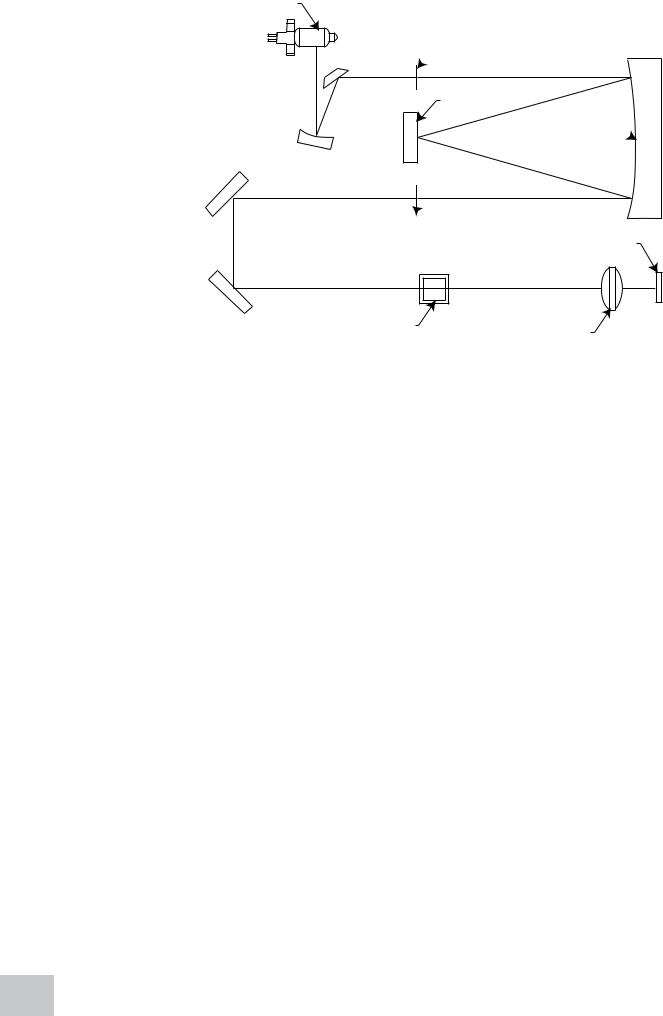
The optical layout of the 7300 and 7305 spectrophotometers is shown below:
Lamp
 Entrance slit
Entrance slit
Grating
Collimator mirror 
 Exit Slit
Exit Slit
Detector
Sample |
Collecting Lens |
|
Figure 3.2.1 – Diagram of light path
The light from the pre-focused tungsten halogen (7300) or pre-aligned xenon (7305) lamp is focused onto the grating, with 1200 lines per millimeter, which separates the light into discreet wavelengths. The diffracted spectrum of light then passes through a further slit and lens arrangement before passing through the sample in the sample chamber from left to right. The light which is not absorbed by the sample is transmitted through a collecting lens and onto the signal detector. The photo-diode detector used is mounted directly onto the detector PCB and is used to calculate the % transmittance. The result is displayed either as % transmittance or absorbance on the instrument display.
3.3GOOD PRACTICE GUIDELINES
1.For optimum performance all spectrophotometers should be sited in a clean, dry, dust free atmosphere. When in use ambient temperature and light levels should remain as constant as possible.
2.If required adherence to Standard Operating Procedures (SOP) and Good Laboratory Practice (GLP) should be monitored with regular calibration checks and a suitable Quality Control (QC) programme.
3.The sample chamber lid must be fully closed during measurement and before any readings are recorded or printed.
4.The correct selection of sample containers is imperative for accurate and reproducible results:
a)Check that the material of the sample container is compatible with the wavelengths to be used for measurement. In general glass can only be used down to 360nm or 320nm depending on quality. Standard plastic cuvettes can be used down to 320nm. Special UV versions can be used down to 260nm. Below this level quartz cuvettes must be used.
b)Plastic disposable cuvettes should only be used ONCE.
c)Glass cuvettes should be thoroughly cleaned after use. Discard when scratches become evident on optical surfaces.
d)Care should be taken when selecting semi-micro or micro cuvettes. The cuvette window on the
14

inner chamber (the area filled with sample) must be wider than the aperture in the sample holder or light will reach the detector without passing through the sample. In this case, semi-micro or micro cuvettes with self-screening black surrounds must be used or, alternative holders for these cuvettes should be used.
e)Glass test tubes and other sample tubes should be used with care. Where possible, matched tubes should be used and any index mark set to the correct position before measurements are made.
f)Ensure any sample containers used are compatible with the constituents of both the samples and standards they are to hold. Plastic cuvettes are not compatible with organic solvents.
g)All sample containers must be handled with care; by the top, bottom and non-optical surfaces only. Any finger marks evident must be removed by a suitable cleaning process.
h)Flow-through cuvettes must be selected with care and consideration for the sample type, sample volume, pumping system, rinse, sample and waste handling to be used.
5.Samples and standards should not be stored in open cuvettes or sample containers as evaporation will change the value and lead to staining of the walls which may be irreversible. If stored in stoppered and sealed cuvettes, they should be filled with little or no air space and the values regularly checked against a reference standard or quality control material.
6.Samples should be allowed to equilibrate to ambient temperature before measurement (unless a suitable temperature controlled sample holder is in use). Temperature change during measurement may cause air bubbles to form on the walls of the sample holder. This is a common cause of drift during measurement.
7.In the preparation of samples and standards high grade borosilicate glass and AR grade chemicals and reagents must be used. Good quality deionised water or other suitable solvents must be used for dissolving or diluting samples, chemicals and reagents.
8.All measurements require calibration to a blank, for maximum accuracy this should be prepared with care using the same deionised water or solvent used for dissolving or diluting the sample. Where reagents are added to the sample to produce a colour proportional to its concentration a ‘sample based’ blank should be used. In this case the blank should consist of all reagents or chemicals to be used, except the sample which will produce the colour to be measured.
9.Deviations from the Beer-Lambert Law may occur at high and low concentrations giving non-linear response during sample concentration measurements. For all new methods a linear range should be defined by the preparation of a calibration curve.
10.Cuvettes and sample holders must be filled to a minimum level which covers the light path. All Jenway spectrophotometers have a beam height of 15mm.
11.The instrument must be calibrated to zero absorbance/100% transmittance prior to taking readings.
15

SECTION 4 – Instrument Setup
4.1NAVIGATING AND SCREEN SETUP
The main menu screen is displayed below.
|
7300 |
Concentration |
|
|
measurement |
|
|
mode |
Photometrics |
09:02 |
|
measurement |
|
Instrument |
mode |
|
|
|
settings menu |
|
|
|
Back key |
|
Time and date menu |
|
Fig 4.1.1 – Home Screen
To navigate around the spectrophotometer screen press the soft keys adjacent to icons displayed on the screen. In the main menu either of the two soft keys adjacent to the measurement mode icon can be pressed to access the mode. There is a back key which returns to the previous menu without saving any changes.
The main menu screen provides access to the measurement modes, the time and date menu and the instrument settings menu. The measurement modes are photometrics and concentration. The instrument settings menu enables access to the screen contrast and lamp save menus.
0.000ABS
100.0%T
400nm
All of the measurement modes open initially into a minimal operating menu. This menu allows calibration and simple readings to be taken without changing any measurement parameters. Pressing the key adjacent to the JW icon opens the expanded operating menu.
09:02
Minimal Operating Menu
0.000ABS
100.0%T
400nm
09:02
Expanded Operating Menu (Photometrics measurement mode)
This menu enables changes to measurement parameters and settings to be made. Depending on the mode, the measurement parameters can be accessed through the settings menu which is displayed in the top right hand corner of the screen. The only mode where this function is not available is the photometrics mode; instead a toggle icon is displayed which is used to change the primary and secondary displays.
16
